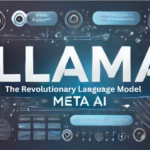The world of artificial intelligence is buzzing with innovation, and at the forefront of this revolution are large language models (LLMs). These powerful AI systems are capable of understanding and generating human-like text, opening up a universe of possibilities. While companies like OpenAI have made waves with models like ChatGPT, Meta AI has quietly entered the arena with its own formidable contender: Llama.
What is Llama?
Llama, short for “Large Language Model Meta AI,” is a family of autoregressive large language models released in February 2023. Unlike its predecessors, Llama was designed with accessibility in mind. Meta AI, recognizing the increasing importance of LLMs in research and development, opted for a more open approach, making Llama’s weights available to the research community under a non-commercial license.
This decision, while initially met with some controversy due to concerns about potential misuse, has been lauded by many as a pivotal moment in the democratization of AI. By making Llama’s inner workings accessible, Meta AI has fostered a collaborative environment where researchers and developers can contribute to the advancement of LLM technology.
The Evolution of Llama: From Research Project to Commercial Powerhouse
Llama’s journey has been marked by significant milestones, each iteration building upon the successes of its predecessors:
Llama 1 (February 2023): The first iteration of Llama, released in February 2023, focused on demonstrating the viability of a smaller, more efficient LLM. Despite having fewer parameters than models like GPT-3, Llama 1 achieved impressive performance on various NLP benchmarks, proving that size isn’t everything in the world of LLMs.
Llama 2 (July 2023): A significant leap forward, Llama 2, released in July 2023, boasted a 40% larger training dataset and a suite of new features. This iteration saw the introduction of instruction fine-tuned models, specifically designed to follow instructions and complete tasks, making Llama 2 a more versatile and user-friendly tool.
Code Llama (August 2023): Recognizing the growing importance of AI in software development, Meta AI released Code Llama, a specialized version of Llama 2 fine-tuned on code-specific datasets. Code Llama excels at understanding and generating code in multiple programming languages, making it an invaluable asset for developers.
Llama 3 (April 2024): The latest and most powerful iteration, Llama 3, released in April 2024, represents a significant jump in capabilities. Trained on a massive dataset of 15 trillion tokens, Llama 3 exhibits improved accuracy, fluency, and a deeper understanding of context. This iteration also saw the introduction of multimodal models, capable of processing both text and images, opening up exciting new possibilities for AI applications.
Llama 3.1 (July 2024): This incremental update to Llama 3, released in July 2024, further refined the model’s capabilities and introduced a new, larger model with 405 billion parameters. Llama 3.1 has shown remarkable performance, surpassing even models like Google’s Gemini and Anthropic’s Claude in many benchmarks.
Inside Llama: A Look at the Architecture and Training
Llama’s success can be attributed to a combination of innovative architectural choices and a rigorous training process:
Architecture:
- Transformer Architecture: Like most modern LLMs, Llama leverages the transformer architecture, a neural network design renowned for its ability to process sequential data like text.
- SwiGLU Activation Function: Llama utilizes the SwiGLU activation function, a more efficient alternative to the commonly used GeLU, contributing to its impressive performance despite its smaller size.
- Rotary Positional Embeddings: Unlike traditional absolute positional embeddings, Llama employs rotary positional embeddings, allowing the model to better understand the relative positions of words within a sentence.
Training:
- Massive Datasets: Llama models are trained on colossal datasets comprising trillions of words, sourced from publicly available text and code repositories. This extensive training data enables Llama to develop a comprehensive understanding of language and its nuances.
- Self-Supervised Learning: Llama primarily utilizes self-supervised learning, a technique where the model learns by predicting masked words within a sentence. This approach allows Llama to learn from vast amounts of unlabeled data, eliminating the need for costly manual annotation.
- Instruction Fine-Tuning: Later iterations of Llama, like Llama 2 and Code Llama, undergo additional instruction fine-tuning. This process involves training the model on a dataset of instructions and responses, enabling it to follow instructions and complete tasks more effectively.
The Impact of Llama: Shaping the Future of AI
Llama’s arrival has sent ripples through the AI community, challenging the status quo and pushing the boundaries of what’s possible with LLMs. Its open approach has fostered a collaborative environment, accelerating research and development in the field.
Here’s how Llama is shaping the future of AI:
- Democratizing AI: By making its models accessible, Meta AI is empowering researchers and developers across the globe to contribute to the advancement of LLM technology. This open approach is crucial for ensuring that the benefits of AI are shared widely and not confined to a select few.
- Fueling Innovation: Llama’s availability has sparked a wave of innovation, with researchers and developers leveraging its capabilities to create novel applications across various domains, from chatbots and virtual assistants to code generation and medical diagnosis.
- Driving Progress in AI Safety: The open nature of Llama allows researchers to delve into the inner workings of LLMs, gaining a deeper understanding of how these models learn and reason. This transparency is crucial for identifying and mitigating potential biases and safety risks associated with AI.
Conclusion: Llama – A Force for Open and Accessible AI
Llama stands as a testament to Meta AI’s commitment to open and accessible AI. By embracing a collaborative approach, Meta AI is not only advancing the state of the art in LLM technology but also fostering an environment where the benefits of AI can be shared by all. As Llama continues to evolve, we can expect even more groundbreaking applications and a future where AI is a force for good, empowering humanity to reach new heights.


